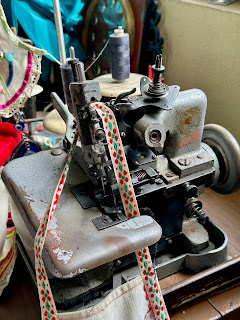As I mentioned in an earlier post, my great grandmother, Rose Deutch Dembowitz, emigrated from Dvinsk, then in the Russian Empire in the province of Vitebsk. The name of the city changed a number of times. The Germans called in Dinaburg; it was called Dvinsk during the Russian Empire; finally, after the second independence in 1991, it was given the name Daugavpils, meaning the "castle on the Dauga River." In 1917, when the area of Latgale was reunited with Latvia, Dvinsk became a part of the Latgale province.
Around the time Rose left Dvinsk there were around 34 synagogues. Today there is one. Jews made up about 47% of the population of the city 1903. After a mass emigration at the turn of the 20th century and World War I, the Jewish population dwindled to 11,106 at the start of World War II. By the end of the war fewer than 100 people remained. Today about 500 Jews call Daugavpils home.
A map of Dunaberg (also spelled Dinaburg)
showing the location of the 34 synagogues
You need an appointment to visit the Daugavpils Synagogue where a docent, usually the president of the synagogue who speaks Russian and what he calls "his beautiful English," shares the story of Jews in the city and takes you on a tour of the synagogue and the quite strange small museum upstairs.
Exterior of the Daugavpils Synagogue
Our docent, Josif Rochko, has authored several books about Jewish life in Daugavpils and Latgale. Some of his commentary included Jewish rituals and objects that need no explanation to most Jewish tourists, but we appreciated his passion. Josif's father had lost his wife and children in the Holocaust, but he remarried, and Josif was born in 1949.
Josif Rochko pointing out the details of the Daugavpils Synagogue
The synagogue at 38 Cietoksna Street was not destroyed in World War II, but, like some others, was used for storage by the Nazi regime. Like many synagogues, the bimah sits in the middle of the room while the ark sits in the front on the Arom HaKodesh.
Arom HaKodesh
Bimah
Upstairs was the strangest museum. As we walked up the steps it was more like walking into a combination junk store with all sorts of strange and ordinary household items. Rose Deutch, like her father Avram Yitzhak Deutch, was a tailor (identified on documents as a "tailoress") who, when she first arrived in Leeds, England and then Brooklyn, New York a year later, made her living sewing until she married. It was for this reason that I was drawn to an old sewing machine on which I could imagine Rose or Avram or Morris (Rose's older brother) working.
Sewing Machine in the Daugavpils Jewish Museum
Upstairs in the synagogue
The main part of the small museum consisted of photos tracing the history of the synagogue and the Jews of Daugavpils. There was a picture of Mark Rothko and his family as well as a photo of Josif Rochko's father. There was documentation of famous and not-so-famous Jews from Dvinsk/Daugavpils including Moshe Harel, the founder of Mossad and the composer Oscar Strok. The official name of the synagogue is Kadish, although it is believed that it is named for a person rather than the prayer. In 2005 the synagogue was restored with the funds donated by the children of Mark Rothko, and, on April 11, the president of Latvia, V. Vike-Freibergs, reopened the restored synagogue


.jpeg)







No comments:
Post a Comment